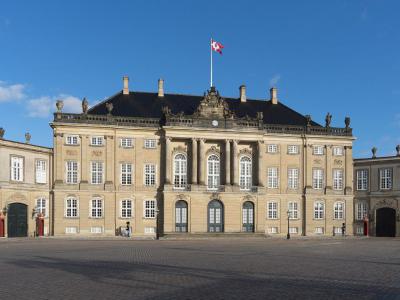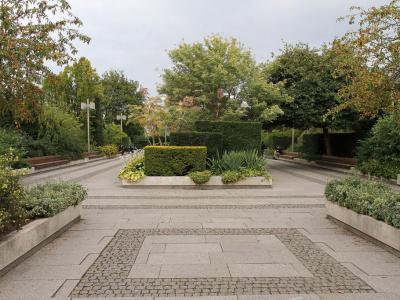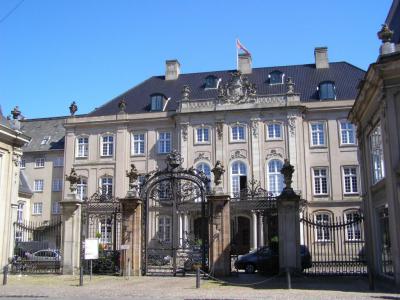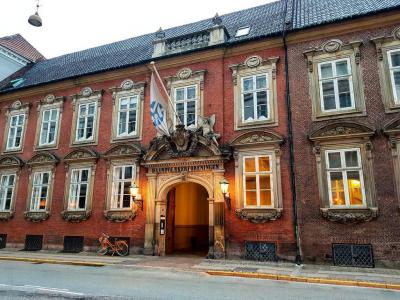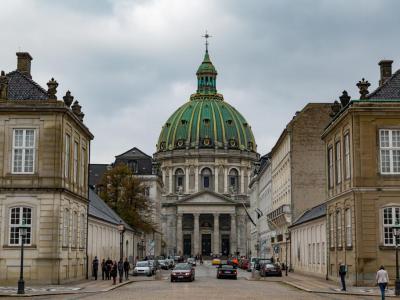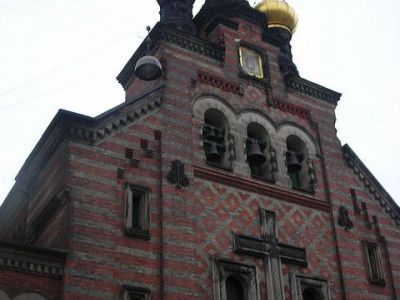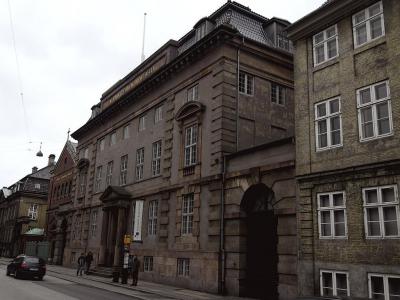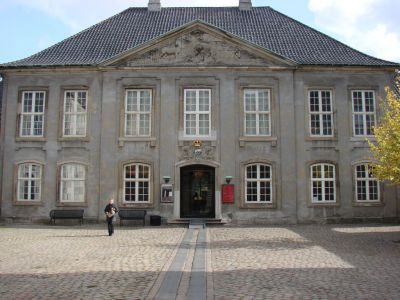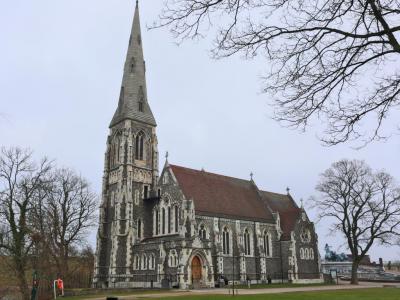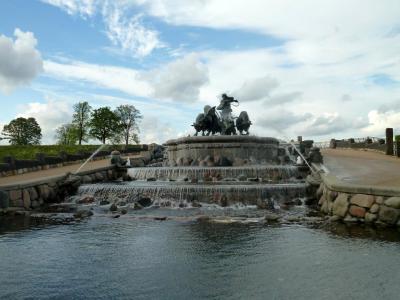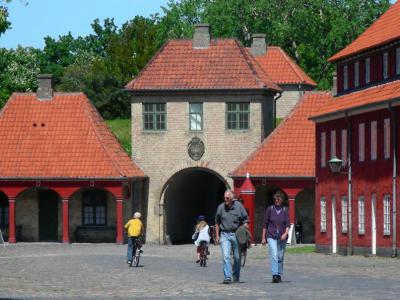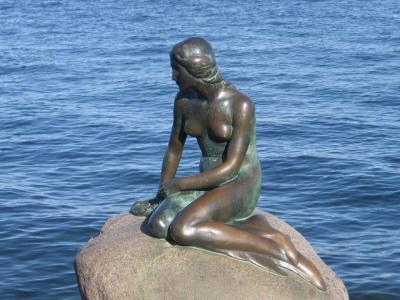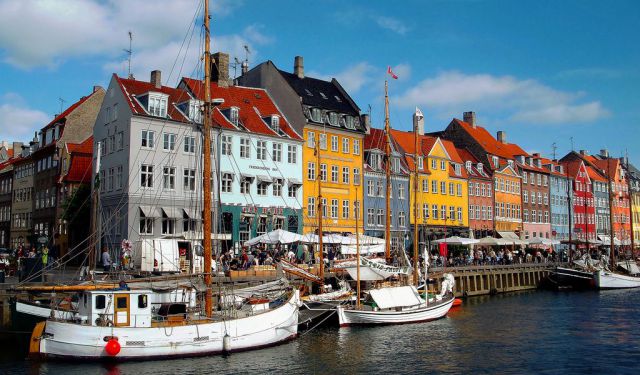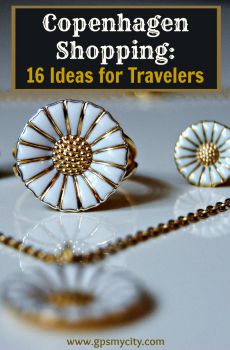Little Mermaid Walking Tour (Self Guided), Copenhagen
Back in the 18th century, Denmark was in the throes of an economic boom. Constructed during the reign of King Frederick V (hence the name), the district of Frederiksstaden attests to that with its beautiful architecture, measuring up to the projects from the same period in Berlin, Paris, and Vienna. This tour will guide you through the area's broad streets lined by bourgeois houses, mansions, and palaces built to glorify the absolute monarchy.
One of the most iconic local landmarks is Amalienborg Palace, a magnificent royal complex composed of four identical rococo residences surrounding an octagonal courtyard. Visitors can explore the Amalienborg Museum, situated in one of these palaces, to gain insights into the Danish monarchy's history. Adjacent to the palace lies Amalie Garden (Amaliehaven), a serene oasis of greenery centered on a large fountain.
Our next stop is the Odd Fellows Mansion and the nearby Moltke Mansion, which are splendid examples of rococo and baroque architecture respectively.
Frederick's Church, also known as the Marble Church, is a striking domed structure that adds to the district's architectural allure. Just a stone's throw away, the Russian Orthodox Alexander Nevsky Church showcases the city's diversity and cultural richness. In the same vein, Saint Alban's Church, designed in English Gothic style, stands as a testament to Denmark's historical connections with Britain.
For those with an interest in medical history, the Medical Museum provides a captivating journey through the evolution of medicine and healthcare. Meanwhile, art enthusiasts can explore the Danish Museum of Art and Design.
The Gefion Fountain, a grand sculpture depicting the Norse goddess Gefion, is another prominent feature in the district.
Kastellet, a well-preserved star-shaped fortress, showcases Danish military history and offers scenic walks along its ramparts.
The highlight of the walk is perhaps the best-known attraction of Copenhagen, the Little Mermaid statue. Situated by the waterfront, this beloved symbol of the city is not Disney's version but Copenhagen's very own!
Whenever you're in Copenhagen, spare no time to explore the charming district of Frederiksstaden. The wealth of cultural and architectural attractions here is going to ensure the time well spent.
One of the most iconic local landmarks is Amalienborg Palace, a magnificent royal complex composed of four identical rococo residences surrounding an octagonal courtyard. Visitors can explore the Amalienborg Museum, situated in one of these palaces, to gain insights into the Danish monarchy's history. Adjacent to the palace lies Amalie Garden (Amaliehaven), a serene oasis of greenery centered on a large fountain.
Our next stop is the Odd Fellows Mansion and the nearby Moltke Mansion, which are splendid examples of rococo and baroque architecture respectively.
Frederick's Church, also known as the Marble Church, is a striking domed structure that adds to the district's architectural allure. Just a stone's throw away, the Russian Orthodox Alexander Nevsky Church showcases the city's diversity and cultural richness. In the same vein, Saint Alban's Church, designed in English Gothic style, stands as a testament to Denmark's historical connections with Britain.
For those with an interest in medical history, the Medical Museum provides a captivating journey through the evolution of medicine and healthcare. Meanwhile, art enthusiasts can explore the Danish Museum of Art and Design.
The Gefion Fountain, a grand sculpture depicting the Norse goddess Gefion, is another prominent feature in the district.
Kastellet, a well-preserved star-shaped fortress, showcases Danish military history and offers scenic walks along its ramparts.
The highlight of the walk is perhaps the best-known attraction of Copenhagen, the Little Mermaid statue. Situated by the waterfront, this beloved symbol of the city is not Disney's version but Copenhagen's very own!
Whenever you're in Copenhagen, spare no time to explore the charming district of Frederiksstaden. The wealth of cultural and architectural attractions here is going to ensure the time well spent.
How it works: Download the app "GPSmyCity: Walks in 1K+ Cities" from Apple App Store or Google Play Store to your mobile phone or tablet. The app turns your mobile device into a personal tour guide and its built-in GPS navigation functions guide you from one tour stop to next. The app works offline, so no data plan is needed when traveling abroad.
Little Mermaid Walking Tour Map
Guide Name: Little Mermaid Walking Tour
Guide Location: Denmark » Copenhagen (See other walking tours in Copenhagen)
Guide Type: Self-guided Walking Tour (Sightseeing)
# of Attractions: 12
Tour Duration: 2 Hour(s)
Travel Distance: 2.8 Km or 1.7 Miles
Author: EmmaS
Sight(s) Featured in This Guide:
Guide Location: Denmark » Copenhagen (See other walking tours in Copenhagen)
Guide Type: Self-guided Walking Tour (Sightseeing)
# of Attractions: 12
Tour Duration: 2 Hour(s)
Travel Distance: 2.8 Km or 1.7 Miles
Author: EmmaS
Sight(s) Featured in This Guide:
- Amalienborg Palace and Museum
- Amaliehaven (Amalie Garden)
- Odd Fellows Mansion
- Moltke Mansion
- Frederick's Church
- Alexander Nevsky Church
- Medical Museion (Medical Museum)
- Danish Museum of Art and Design
- St. Alban's Church
- Gefion Fountain
- Kastellet
- Little Mermaid
1) Amalienborg Palace and Museum (must see)
Amalienborg Palace is the official residence of the Danish Royal Family. This palace complex features four rococo palaces constructed between 1750 and 1758. All are built around the octagonal square where you will find King Frederik’s equestrian statue. King Frederik ruled Norway and Denmark between 1723 and 1766 and was instrumental in the construction of Frederiksstad of which Amalienborg palace is a part.
Land for the palace was acquired by King Christian IV who ruled Norway and Denmark between 1577 and 1648. Queen Sophie Amalie, King Frederik III’s consort constructed the first palace in this waterfront area between 1669 and 1673. This palace was destroyed by fire in 1689.
King Frederik IV constructed the second royal palace at Amalienborg during his rule between 1671 and 1730. This was a two-storied small summer residence that featured a charming French garden. It was named Sophie Amalienborg.
In the 1980s the palace was restored as residence for the Crown Prince, storage facilities for the Queen’s Reference Library and a museum for the Royal House of Glücksborg. The museum features private royal apartments from 1863 to 1947 including original fittings and furnishings.
King Frederik V, in his effort to create a separate city outside Copenhagen, constructed Frederik’s City or Frederiksstad that featured exclusive homes for the noble families and aristocrats. All buildings were in Baroque style. Later on, additions were made to these buildings in rococo architectural style. Make sure you include Amalienborg Palace in your itinerary when you visit Copenhagen.
Why You Should Visit:
Considered as one of the best examples of the Rococo architecture style, this complex is beautifully preserved and feels more intimate than its European counterparts.
Tip:
Arrive at midday for the changing of the guard, an interesting display that takes around 10 minutes.
Land for the palace was acquired by King Christian IV who ruled Norway and Denmark between 1577 and 1648. Queen Sophie Amalie, King Frederik III’s consort constructed the first palace in this waterfront area between 1669 and 1673. This palace was destroyed by fire in 1689.
King Frederik IV constructed the second royal palace at Amalienborg during his rule between 1671 and 1730. This was a two-storied small summer residence that featured a charming French garden. It was named Sophie Amalienborg.
In the 1980s the palace was restored as residence for the Crown Prince, storage facilities for the Queen’s Reference Library and a museum for the Royal House of Glücksborg. The museum features private royal apartments from 1863 to 1947 including original fittings and furnishings.
King Frederik V, in his effort to create a separate city outside Copenhagen, constructed Frederik’s City or Frederiksstad that featured exclusive homes for the noble families and aristocrats. All buildings were in Baroque style. Later on, additions were made to these buildings in rococo architectural style. Make sure you include Amalienborg Palace in your itinerary when you visit Copenhagen.
Why You Should Visit:
Considered as one of the best examples of the Rococo architecture style, this complex is beautifully preserved and feels more intimate than its European counterparts.
Tip:
Arrive at midday for the changing of the guard, an interesting display that takes around 10 minutes.
2) Amaliehaven (Amalie Garden)
Amaliehaven also known as Amalie Garden is situated in central Copenhagen’s Frederiksstaden neighbourhood between the water front and the Amalienborg Palace. This small park was gifted to the city by the A.P. Moller and Chastine McKinney Moller Foundation in 1953.
The park was first created over an ancient shipyard established by Lars Larsen, a rich ship owner in 1802. Jean Delogne, the Belgian landscape architect designed this garden that was inaugurated in 1983.
The park is rectangle shaped with a large fountain at the center. The design is symmetrical and is exquisitely complemented by the naturally flowering plants. You will find two levels of the garden extending on either sides of the central fountain. One side of the garden is enclosed by the street and the other by walls and shrubs.
You will also find a stunning variety of flowers and plants in this garden. The effect is amazing with natural shapes of flowers contrasting the park’s geometric layout. If you visit Amaliehaven in April, you are extremely lucky as you will find the Japanese cherry trees in full bloom. These trees are indeed the highlight of this park.
All sculptures you find here are sculpted by Arnaldo Pomodoro, the famous Italian sculptor. There are four attractive abstract columns and water features that sprinkle jets of water.
The park was first created over an ancient shipyard established by Lars Larsen, a rich ship owner in 1802. Jean Delogne, the Belgian landscape architect designed this garden that was inaugurated in 1983.
The park is rectangle shaped with a large fountain at the center. The design is symmetrical and is exquisitely complemented by the naturally flowering plants. You will find two levels of the garden extending on either sides of the central fountain. One side of the garden is enclosed by the street and the other by walls and shrubs.
You will also find a stunning variety of flowers and plants in this garden. The effect is amazing with natural shapes of flowers contrasting the park’s geometric layout. If you visit Amaliehaven in April, you are extremely lucky as you will find the Japanese cherry trees in full bloom. These trees are indeed the highlight of this park.
All sculptures you find here are sculpted by Arnaldo Pomodoro, the famous Italian sculptor. There are four attractive abstract columns and water features that sprinkle jets of water.
3) Odd Fellows Mansion
The Odd Fellows Mansion is a significant Rococo-style town mansion located in Copenhagen. It gained its current name when it was acquired by the local branch of the Independent Order of Odd Fellows in 1900. Before this acquisition, it was known through its history as the Berckentin Mansion and later the Schimmelmann Mansion, reflecting the names of its notable owners.
The mansion's origins date back to the redevelopment of the Frederiksstaden district, a project under the creative guidance of architect Nicolai Eigtved. Eigtved's vision for the district included the design of the mansion, which was executed by Johann Gottfried Rosenberg. It was originally built to serve as the residence for Christian August von Berckentin, a wealthy merchant and politician who was recently ennobled with the title of Count.
In 1762, the mansion was purchased by Heinrich von Schimmelmann, leading to its rechristening as the Schimmelmann Mansion. It continued to serve as a prominent cultural hub under the ownership of Ernst Schimmelmann, Heinrich's son, who inherited it in 1782. Ernst and his wife, Charlotte Schimmelmann, were passionate patrons of the arts. Charlotte, particularly, became renowned for hosting salons that attracted various cultural figures, thereby enhancing the mansion's reputation as a center for vibrant cultural life.
Today, the mansion is not only a historical building but also a cultural venue. It includes a concert hall that is accessible to the public, furthering its legacy as a place of gathering and cultural exchange. Additionally, the Odd Fellows Mansion has served as a picturesque location for various film and television productions, including the 1997 film "Smilla's Sense of Snow" and an episode of the TV series "Matador," highlighting its architectural and historical significance.
The mansion's origins date back to the redevelopment of the Frederiksstaden district, a project under the creative guidance of architect Nicolai Eigtved. Eigtved's vision for the district included the design of the mansion, which was executed by Johann Gottfried Rosenberg. It was originally built to serve as the residence for Christian August von Berckentin, a wealthy merchant and politician who was recently ennobled with the title of Count.
In 1762, the mansion was purchased by Heinrich von Schimmelmann, leading to its rechristening as the Schimmelmann Mansion. It continued to serve as a prominent cultural hub under the ownership of Ernst Schimmelmann, Heinrich's son, who inherited it in 1782. Ernst and his wife, Charlotte Schimmelmann, were passionate patrons of the arts. Charlotte, particularly, became renowned for hosting salons that attracted various cultural figures, thereby enhancing the mansion's reputation as a center for vibrant cultural life.
Today, the mansion is not only a historical building but also a cultural venue. It includes a concert hall that is accessible to the public, furthering its legacy as a place of gathering and cultural exchange. Additionally, the Odd Fellows Mansion has served as a picturesque location for various film and television productions, including the 1997 film "Smilla's Sense of Snow" and an episode of the TV series "Matador," highlighting its architectural and historical significance.
4) Moltke Mansion
Moltke's Mansion, also known as Moltke's Palace, is a striking example of Baroque architecture in Copenhagen. Situated at the intersection of Bredgade and Dronningens Tværgade, it stands as one of the prominent town mansions in the Frederiksstaden area, yet notably predates the neighborhood by about fifty years.
Constructed between 1700 and 1702 for Ulrik Frederik Gyldenløve, an illegitimate son of King Frederick III of Denmark, the mansion replaced an earlier structure from the 1680s on the same site. Initially called Gyldenløve's Little Mansion to differentiate it from his larger Charlottenborg Palace, it was renamed Moltke's Mansion in 1842 when it was acquired by Adam Wilhelm Moltke, Denmark’s first Prime Minister under the constitutional monarchy, marking a key period in its history. The mansion's construction was overseen by architect Ernst Brandenburger.
Moltke's Mansion is renowned for its elaborate Baroque style, including a main facade on Bredgade that features nine bays with giant pilasters marking its grandeur. The rich sandstone decorations include motifs of elephants, lion heads, and flowering vines. These elements, along with a sculpted balustrade, are primarily the result of modifications by Krieger.
Internally, the mansion boasts significant artistic contributions from Erik Pauelsen, especially in the Dronninggaard Salon. Named after the Dronninggård country house, this salon features murals and overdoors painted by Pauelsen, depicting idyllic scenes and topographical views. The first floor houses the Dronninggaard Chambers, which, along with the Green Room, features paintings of local landscapes such as the Hermitage Lodge and the Sound. The Golden Hall stands out with murals by Bjørn Nørgaard, which narrate the history of craftsmanship.
Today, Moltke's Mansion remains under the stewardship of the Association of Craftsmen in Copenhagen. It serves a functional role as a venue for banquets, meetings, and small conferences, continuing its legacy as a center of cultural and social gatherings. Its architectural beauty and rich historical layers make it a cherished landmark in Copenhagen's urban landscape, bridging the city's regal past with its present cultural fabric.
Constructed between 1700 and 1702 for Ulrik Frederik Gyldenløve, an illegitimate son of King Frederick III of Denmark, the mansion replaced an earlier structure from the 1680s on the same site. Initially called Gyldenløve's Little Mansion to differentiate it from his larger Charlottenborg Palace, it was renamed Moltke's Mansion in 1842 when it was acquired by Adam Wilhelm Moltke, Denmark’s first Prime Minister under the constitutional monarchy, marking a key period in its history. The mansion's construction was overseen by architect Ernst Brandenburger.
Moltke's Mansion is renowned for its elaborate Baroque style, including a main facade on Bredgade that features nine bays with giant pilasters marking its grandeur. The rich sandstone decorations include motifs of elephants, lion heads, and flowering vines. These elements, along with a sculpted balustrade, are primarily the result of modifications by Krieger.
Internally, the mansion boasts significant artistic contributions from Erik Pauelsen, especially in the Dronninggaard Salon. Named after the Dronninggård country house, this salon features murals and overdoors painted by Pauelsen, depicting idyllic scenes and topographical views. The first floor houses the Dronninggaard Chambers, which, along with the Green Room, features paintings of local landscapes such as the Hermitage Lodge and the Sound. The Golden Hall stands out with murals by Bjørn Nørgaard, which narrate the history of craftsmanship.
Today, Moltke's Mansion remains under the stewardship of the Association of Craftsmen in Copenhagen. It serves a functional role as a venue for banquets, meetings, and small conferences, continuing its legacy as a center of cultural and social gatherings. Its architectural beauty and rich historical layers make it a cherished landmark in Copenhagen's urban landscape, bridging the city's regal past with its present cultural fabric.
5) Frederick's Church (must see)
Also known as the Marble Church, Frederick’s Church is one of the most popular tourist attractions in Copenhagen – especially for its dome which is the largest in Scandinavia. This dome spans 31 meters and is supported by 12 columns.
Along with all other structures in Frederiksstaden district, the church was built to commemorate a member of the House of Oldenburg’s 300 years coronation jubilee celebrations. It was designed and erected by architect Nicolai Eigtved in 1740. King Frederick V laid the foundation stone in 1749. Eigtved died in 1754 due to which construction was hit by budget constraints and had to be stalled.
Johann Friedrich Struensee discarded the original plan in 1770 and the church remained incomplete for a while in spite of many efforts. For the next 150 years, the edifice remained in ruins. Carl Frederik Tietgen eventually got prominent architect Ferdinand Meldahl to design the church in its final form and financed its construction. Due to financial restrictions, the original plans for the church to be built almost entirely from marble were discarded, and instead, Meldahl opted for construction to be done with limestone. The church was finally opened to the public on August 19, 1894.
A series of statues of prominent theologians and ecclesiastical figures, including one of the eminent Danish philosopher Kierkegaard (who, incidentally, had become very critical of the established church by the end of his life), encircles the grounds of the building.
Why You Should Visit:
This church really has the wow factor; as beautiful inside as it is out (also, rather unique and unusual as it is circular inside).
Tip:
The dome can be visited – for a small fee – every day at 1pm sharp in summer but only at the weekend (Sat/Sun) in winter. Very impressive view from above!
Along with all other structures in Frederiksstaden district, the church was built to commemorate a member of the House of Oldenburg’s 300 years coronation jubilee celebrations. It was designed and erected by architect Nicolai Eigtved in 1740. King Frederick V laid the foundation stone in 1749. Eigtved died in 1754 due to which construction was hit by budget constraints and had to be stalled.
Johann Friedrich Struensee discarded the original plan in 1770 and the church remained incomplete for a while in spite of many efforts. For the next 150 years, the edifice remained in ruins. Carl Frederik Tietgen eventually got prominent architect Ferdinand Meldahl to design the church in its final form and financed its construction. Due to financial restrictions, the original plans for the church to be built almost entirely from marble were discarded, and instead, Meldahl opted for construction to be done with limestone. The church was finally opened to the public on August 19, 1894.
A series of statues of prominent theologians and ecclesiastical figures, including one of the eminent Danish philosopher Kierkegaard (who, incidentally, had become very critical of the established church by the end of his life), encircles the grounds of the building.
Why You Should Visit:
This church really has the wow factor; as beautiful inside as it is out (also, rather unique and unusual as it is circular inside).
Tip:
The dome can be visited – for a small fee – every day at 1pm sharp in summer but only at the weekend (Sat/Sun) in winter. Very impressive view from above!
6) Alexander Nevsky Church
Built by the Russian government, Alexander Nevsky Church holds the distinction of being the only one of its kind in Copenhagen. This Russian Orthodox Church was constructed between 1881 and 1883 to commemorate the wedding of Alexander Alexandrovich and Princess Dagmar of Denmark and is dedicated to Alexander Nevsky, the Russian patron saint.
The church was designed by David Ivanovich Grimm, the Russian architect, and was funded by Tsar Alexander III. David Ivanovich, a professor at Saint Petersburg-based Imperial Academy of Arts, was one of the winners in an architectural competition. His design was executed by Albert Nielsen, the Danish architect, and was supervised by Ferdinand Meldahl.
The Church was consecrated by the Chancellor of the Theological Academy in Saint Petersburg, Provost Janysev in 1883. He was assisted by a monk from Saint Petersburg Alexander Nevsky Lavra and by the priest of the congregation. The ceremony was attended by Greek, Russian, and Danish royal families.
From the outside, you will find this impressive church designed in 17th-century Muscovite architectural style. You will find three prominent onion domes dominating the building. These street-facing domes are on top of the gable.
Highlights of the grey and red brick facade are the ornamentations in sandstone. Do not miss out on the patron saint Alexander Nevsky’s statue above the bells standing high on the facade.
The church was designed by David Ivanovich Grimm, the Russian architect, and was funded by Tsar Alexander III. David Ivanovich, a professor at Saint Petersburg-based Imperial Academy of Arts, was one of the winners in an architectural competition. His design was executed by Albert Nielsen, the Danish architect, and was supervised by Ferdinand Meldahl.
The Church was consecrated by the Chancellor of the Theological Academy in Saint Petersburg, Provost Janysev in 1883. He was assisted by a monk from Saint Petersburg Alexander Nevsky Lavra and by the priest of the congregation. The ceremony was attended by Greek, Russian, and Danish royal families.
From the outside, you will find this impressive church designed in 17th-century Muscovite architectural style. You will find three prominent onion domes dominating the building. These street-facing domes are on top of the gable.
Highlights of the grey and red brick facade are the ornamentations in sandstone. Do not miss out on the patron saint Alexander Nevsky’s statue above the bells standing high on the facade.
7) Medical Museion (Medical Museum)
Medical Museion is a part of the University of Copenhagen’s Faculty of Health Sciences. This museum is also a research unit dedicated to history of disease and health from a cultural perspective. It is housed in Frederiksstaden on Bredgade in a very old building dating back to 1787. This building was designed by Peter Meyn in neo-classical style. The Academy of Surgery responsible for educating surgeons was housed here from 1785 to 1842.
As you browse around, you will find that the main focus of this museum is the recent advancements in the field of biomedicine. You will find displays related to the iconographic culture of biomedicine here.
It was in 1906 that a group of Copenhagen based medical doctors founded the impressive collections at this unique museum. On the occasion of the 50th year celebrations of the Danish Medical Association, the Medical Museion held its first ever exhibition on August 22nd, 1907. At that time, the museum was situated at the Fredericiagade Rigsdag building. It was moved to its present location in 1947.
Originally the museum was called the Museum of Medical History. It was only from 2004 that it is referred to as Medical Museion. As part of the training, dissections were carried out in the central space which is used as the exhibition space today.
As you browse around, you will find that the main focus of this museum is the recent advancements in the field of biomedicine. You will find displays related to the iconographic culture of biomedicine here.
It was in 1906 that a group of Copenhagen based medical doctors founded the impressive collections at this unique museum. On the occasion of the 50th year celebrations of the Danish Medical Association, the Medical Museion held its first ever exhibition on August 22nd, 1907. At that time, the museum was situated at the Fredericiagade Rigsdag building. It was moved to its present location in 1947.
Originally the museum was called the Museum of Medical History. It was only from 2004 that it is referred to as Medical Museion. As part of the training, dissections were carried out in the central space which is used as the exhibition space today.
8) Danish Museum of Art and Design
The Danish Museum of Art & Design, located in Copenhagen, is a significant institution showcasing Danish and international design and crafts. Originally known as the Danish Museum of Decorative Art, its Danish name is Kunstindustrimuseet. The museum is housed in a historic building that was once Frederiks Hospital, remodeled in the 1920s into a museum by architects including Kaare Klint.
Renowned for its extensive collection, the museum features works from eminent Danish designers such as Arne Jacobsen, Jacob Jensen, and Kaare Klint. It also includes an impressive display of Chinese and German porcelain, showcasing a broad scope in design aesthetics and history.
One of the museum's most remarkable resources is its library, the largest in Scandinavia dedicated to design. It serves as a museum library, a research library, and the central library for the field in Denmark. The library is open to the public from Tuesday to Friday and houses over 1,000 journals, with the most current issues of 75 journals available in its reading room. This space also hosts public lectures that explore themes related to the museum’s and library's collections.
Additionally, the museum includes the Danish Design Archive and the Poster Collection, both situated on the first floor. These collections further enrich the museum's offerings, providing deeper insights into Danish design heritage.
The facility also boasts a small auditorium on the first floor, which seats 120 people. This space is versatile, and used for lectures, concerts, receptions, and other events, emphasizing the museum's role as a cultural hub in Copenhagen.
Renowned for its extensive collection, the museum features works from eminent Danish designers such as Arne Jacobsen, Jacob Jensen, and Kaare Klint. It also includes an impressive display of Chinese and German porcelain, showcasing a broad scope in design aesthetics and history.
One of the museum's most remarkable resources is its library, the largest in Scandinavia dedicated to design. It serves as a museum library, a research library, and the central library for the field in Denmark. The library is open to the public from Tuesday to Friday and houses over 1,000 journals, with the most current issues of 75 journals available in its reading room. This space also hosts public lectures that explore themes related to the museum’s and library's collections.
Additionally, the museum includes the Danish Design Archive and the Poster Collection, both situated on the first floor. These collections further enrich the museum's offerings, providing deeper insights into Danish design heritage.
The facility also boasts a small auditorium on the first floor, which seats 120 people. This space is versatile, and used for lectures, concerts, receptions, and other events, emphasizing the museum's role as a cultural hub in Copenhagen.
9) St. Alban's Church
Saint Alban's Church, often referred to as the English Church is an Anglican church located in Copenhagen. It was constructed between 1885 and 1887 to cater to the burgeoning English congregation in the city. The church is situated in a serene park at the end of Amaliegade in the city center's northern part, adjacent to the Kastellet citadel and near the Gefion Fountain and Langelinie.
Designed by the renowned Arthur Blomfield, Saint Alban's exemplifies the Gothic Revival architectural style, specifically inspired by the Early English or Lancet Gothic style. Blomfield, who was a prolific architect of parish churches in Britain and a recipient of the Royal Institute of British Architects' Royal Gold Medal in 1891, imparted a traditional English parish church aesthetic to Saint Alban's. The church features materials such as limestone from Faxe, knapped flint from Stevns, and Åland stone for the spire, with flint being a particularly distinct material reflecting traditional English church constructions, especially in East Anglia.
The church is adorned with a tower containing fifteen tubular bells, introduced as the structure was not robust enough to support regular bells. Initially, eight bells were gifted by the Prince of Wales during the church's construction, playable manually via an Ellacombe Frame. In 2013, the Prince of Wales funded the addition of seven more bells, enabling all fifteen to be played automatically by a computer. These bells chime quarterly and play hymns hourly, with the original bells made by Harringtons and the additional ones sourced from Holy Trinity Church, Oswestry.
Designed by the renowned Arthur Blomfield, Saint Alban's exemplifies the Gothic Revival architectural style, specifically inspired by the Early English or Lancet Gothic style. Blomfield, who was a prolific architect of parish churches in Britain and a recipient of the Royal Institute of British Architects' Royal Gold Medal in 1891, imparted a traditional English parish church aesthetic to Saint Alban's. The church features materials such as limestone from Faxe, knapped flint from Stevns, and Åland stone for the spire, with flint being a particularly distinct material reflecting traditional English church constructions, especially in East Anglia.
The church is adorned with a tower containing fifteen tubular bells, introduced as the structure was not robust enough to support regular bells. Initially, eight bells were gifted by the Prince of Wales during the church's construction, playable manually via an Ellacombe Frame. In 2013, the Prince of Wales funded the addition of seven more bells, enabling all fifteen to be played automatically by a computer. These bells chime quarterly and play hymns hourly, with the original bells made by Harringtons and the additional ones sourced from Holy Trinity Church, Oswestry.
10) Gefion Fountain
The Gefion Fountain, located on the harbourfront in Copenhagen, is a striking and elaborate fountain that celebrates a blend of art and mythology. This monumental fountain features a dynamic sculpture of the Norse goddess Gefjon driving a group of animals. These figures are not just any animals, but her four sons whom she transformed into oxen to perform a tremendous mythological feat.
The mythology behind the fountain is rooted in ancient Norse legends that describe the creation of Zealand, the island on which Copenhagen is situated. This tale is vividly recounted in several old texts, including the Prose Edda and Heimskringla by the 13th-century Icelandic historian Snorri Sturluson, as well as in Ragnarsdrápa, a 9th-century Skaldic poem.
According to the legend, the Swedish king Gylfi promised Gefjon as much land as she could plow in one night. To accomplish this task, Gefjon transformed her four sons into powerful oxen. The land they plowed was then thrown into the Danish sea, forming the island of Zealand. The void left by the removed earth became a lake, known in ancient texts as Lögrinn or Leginum, which is identified by Snorri Sturluson as Lake Mälaren, near Stockholm.
Interestingly, despite Snorri's specific identification of Lake Mälaren, tourist information typically connects the story with Lake Vänern, Sweden's largest lake. This is largely due to perceived similarities in size and shape between Zealand and Vänern, suggesting a different geographical interpretation from Snorri's historical accounts.
The Gefion Fountain not only serves as a key historical landmark but also as a symbol of Copenhagen’s rich cultural heritage intertwined with Norse mythology. Its dramatic sculptures and the powerful story they depict attract numerous visitors and provide insight into the mythological origins of the region.
The mythology behind the fountain is rooted in ancient Norse legends that describe the creation of Zealand, the island on which Copenhagen is situated. This tale is vividly recounted in several old texts, including the Prose Edda and Heimskringla by the 13th-century Icelandic historian Snorri Sturluson, as well as in Ragnarsdrápa, a 9th-century Skaldic poem.
According to the legend, the Swedish king Gylfi promised Gefjon as much land as she could plow in one night. To accomplish this task, Gefjon transformed her four sons into powerful oxen. The land they plowed was then thrown into the Danish sea, forming the island of Zealand. The void left by the removed earth became a lake, known in ancient texts as Lögrinn or Leginum, which is identified by Snorri Sturluson as Lake Mälaren, near Stockholm.
Interestingly, despite Snorri's specific identification of Lake Mälaren, tourist information typically connects the story with Lake Vänern, Sweden's largest lake. This is largely due to perceived similarities in size and shape between Zealand and Vänern, suggesting a different geographical interpretation from Snorri's historical accounts.
The Gefion Fountain not only serves as a key historical landmark but also as a symbol of Copenhagen’s rich cultural heritage intertwined with Norse mythology. Its dramatic sculptures and the powerful story they depict attract numerous visitors and provide insight into the mythological origins of the region.
11) Kastellet (must see)
One of the most impressive and well-preserved fortifications in Northern Europe, Kastellet, as it is called, has bastions at the corners and is designed in the form of a pentagram. As you enter its grounds, you will find a number of buildings including a windmill and a church. This historic site which also serves as a public park is frequented by locals and tourists alike.
It was in 1626 that King Christian IV started construction of Kastellet. Economic constraints forced him to drop his grand plans of building a large castle here. King Frederik III, his successor continued with the construction which was later extended by Henrik Ruse, the Dutch engineer after the Swedish siege between 1658 and 1660.
Kastellet was built as an effort by Copenhagen to defend itself against England in the 1807 Battle of Copenhagen. A.P. Moller and Chastine McKinney Mollers General Fund made possible a complete renovation of Kastellet between 1989 and 1999. Currently, it is owned by the Danish Defence Ministry and the area is used by Defence Intelligence, Danish Home Guard, Chief of Staff, Royal Garrison’s Library and the Defence Judge Advocate Corps.
Locals visit Kastellet to enjoy a pleasant walk on a sunny day. Tourists visit this fortification for its rich heritage and children love to play around with the birds and animals here.
Why You Should Visit:
The high walls of the fortress offer a lovely view of the harbor, and the fact that half of it is still a working base means it's kept in tip top shape.
Very pleasant area to take a quiet stroll or run, and with a charming windmill to boot!
Tip:
Can get windy on a cold day so do cover up.
It was in 1626 that King Christian IV started construction of Kastellet. Economic constraints forced him to drop his grand plans of building a large castle here. King Frederik III, his successor continued with the construction which was later extended by Henrik Ruse, the Dutch engineer after the Swedish siege between 1658 and 1660.
Kastellet was built as an effort by Copenhagen to defend itself against England in the 1807 Battle of Copenhagen. A.P. Moller and Chastine McKinney Mollers General Fund made possible a complete renovation of Kastellet between 1989 and 1999. Currently, it is owned by the Danish Defence Ministry and the area is used by Defence Intelligence, Danish Home Guard, Chief of Staff, Royal Garrison’s Library and the Defence Judge Advocate Corps.
Locals visit Kastellet to enjoy a pleasant walk on a sunny day. Tourists visit this fortification for its rich heritage and children love to play around with the birds and animals here.
Why You Should Visit:
The high walls of the fortress offer a lovely view of the harbor, and the fact that half of it is still a working base means it's kept in tip top shape.
Very pleasant area to take a quiet stroll or run, and with a charming windmill to boot!
Tip:
Can get windy on a cold day so do cover up.
12) Little Mermaid (must see)
On your trip to Copenhagen, take time off to visit the harbor where you will find the Little Mermaid statue. This statue is the icon of Copenhagen and is visited by tourists from across the world. The unimposing statue is based on one of Hans Christian Anderson’s fairy tales.
After enjoying a ballet on this fairy tale at the Royal Theatre, Carlsberg founder’s son Carl Jacobsen commissioned the statue in 1909. It was modeled after none other than Ellen Price, the prima ballerina (well, partly, at least).
The statue is made of bronze and was painstakingly created by expert sculptor, Edvard Eriksen. Unveiled in 1913, the statue has Ellen Price’s head and Eline Eriksen, the sculptor’s wife’s body.
The Little Mermaid statue surprisingly weighs only around 175 kg and is 1.25 meters tall. Its small size is a surprise for first-time visitors who expect to see something grand and huge.
Why You Should Visit:
To watch people fall into the water as they try to get a photo with the statue (this happens more often than you'd think).
Tip:
The perfect spot for taking a picture is from the promenade overlooking the statue to the left. It's a great photo op, not only of the mermaid but the Copenhagen harbour behind.
After enjoying a ballet on this fairy tale at the Royal Theatre, Carlsberg founder’s son Carl Jacobsen commissioned the statue in 1909. It was modeled after none other than Ellen Price, the prima ballerina (well, partly, at least).
The statue is made of bronze and was painstakingly created by expert sculptor, Edvard Eriksen. Unveiled in 1913, the statue has Ellen Price’s head and Eline Eriksen, the sculptor’s wife’s body.
The Little Mermaid statue surprisingly weighs only around 175 kg and is 1.25 meters tall. Its small size is a surprise for first-time visitors who expect to see something grand and huge.
Why You Should Visit:
To watch people fall into the water as they try to get a photo with the statue (this happens more often than you'd think).
Tip:
The perfect spot for taking a picture is from the promenade overlooking the statue to the left. It's a great photo op, not only of the mermaid but the Copenhagen harbour behind.
Walking Tours in Copenhagen, Denmark
Create Your Own Walk in Copenhagen
Creating your own self-guided walk in Copenhagen is easy and fun. Choose the city attractions that you want to see and a walk route map will be created just for you. You can even set your hotel as the start point of the walk.
Copenhagen Introduction Walking Tour
The Danish capital Copenhagen is a fairy tale of a city, full of peculiarities. Its name – derived from the Danish words for merchant ("køpmann") and harbor ("havn") – reflects the city's origin as a place of commerce by the sea. A humble fishing village, established in the 10th century AD, some hundred years later it emerged as a town after Bishop Absalon, recognized... view more
Tour Duration: 2 Hour(s)
Travel Distance: 2.7 Km or 1.7 Miles
Tour Duration: 2 Hour(s)
Travel Distance: 2.7 Km or 1.7 Miles
Castle Island (Slotsholmen) Walking Tour
Castle Island, sitting outside Copenhagen Harbor, proudly holds the title of the Danish capital’s birthplace. Back in 1167, Bishop Absalon built a small fortress on what was then a cluster of soggy little islets. Unfortunately, the Hanseatic League didn’t think much of the place and destroyed it in 1369. But like any good comeback story, the castle rose from the rubble and became Copenhagen... view more
Tour Duration: 1 Hour(s)
Travel Distance: 1.6 Km or 1 Miles
Tour Duration: 1 Hour(s)
Travel Distance: 1.6 Km or 1 Miles
Hans Christian Andersen's Copenhagen
Before Disney glamorized fairy tales, Hans Christian Andersen was the original master of childhood magic. Best known for stories like The Little Mermaid, The Ugly Duckling, The Emperor’s New Clothes, and Thumbelina, Andersen essentially built the foundation of fairy-tale literature-dark undertones and all...
Born in 1805 in Odense, in the middle of the country, Andersen grew up in poverty,... view more
Tour Duration: 2 Hour(s)
Travel Distance: 2.9 Km or 1.8 Miles
Born in 1805 in Odense, in the middle of the country, Andersen grew up in poverty,... view more
Tour Duration: 2 Hour(s)
Travel Distance: 2.9 Km or 1.8 Miles
Latin Quarter Walking Tour
One of the most interesting, young-spirited neighborhoods of Denmark's capital, the Latin Quarter is well known for its hangout spots, alternative shopping, and 18th-century architecture.
Back in the Middle Ages, the area surrounding Our Lady's Square (“Frue Plads” in Danish), right in the heart of it, was considered a “ray of light” in the overall darkness of those times. A... view more
Tour Duration: 1 Hour(s)
Travel Distance: 1.7 Km or 1.1 Miles
Back in the Middle Ages, the area surrounding Our Lady's Square (“Frue Plads” in Danish), right in the heart of it, was considered a “ray of light” in the overall darkness of those times. A... view more
Tour Duration: 1 Hour(s)
Travel Distance: 1.7 Km or 1.1 Miles
Useful Travel Guides for Planning Your Trip
Copenhagen Shopping: 16 Distinctively Denmark Things to Buy
Denmark is renowned for simple, industrial and functional design, as well as bohemian and everyday fashion-wear for the individual urban living. The capital Copenhagen, home to Copenhagen Fashion Week twice a year and biannual INDEX: Design to Improve Life - the world’s biggest design awards, is...
The Most Popular Cities
/ view all



